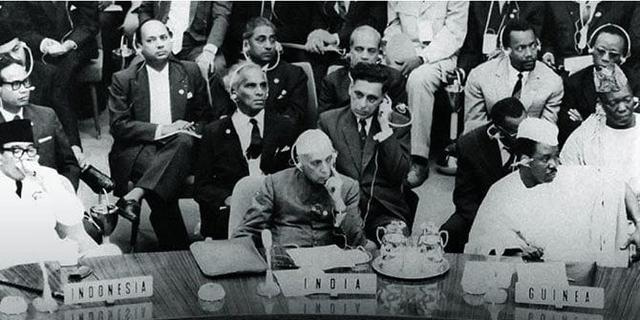重庆开州龚炯(龚炯大融合)
导读:11月2日,由清华大学战略与安全研究中心中国论坛参与主办的首届“思想亚洲THINK ASIA”智库论坛在新加坡举办。论坛汇聚中、新、印、泰、日、韩等亚洲国家的众多学者,围绕亚洲发展、经济前景、安全形势、风险管理、创新机制等热点问题展开讨论。对外经济贸易大学以色列分校副校长、中国论坛特约专家龚炯受邀出席并发表讲话。 11月11日,龚炯在《南华早报》发表评论文章“An Asia of the Asians, by the Asians, for the Asians”( 一个亚洲人有、亚洲人治和亚洲人享的亚洲) 文章认为,“亚洲人的亚洲”是一个集体愿景,是多样性的体现,是一个正在崛起的地区发出呼声:亚洲的命运,亚洲的和平繁荣和亚洲人的幸福,应由亚洲人民来决定。
【文/观察者网专栏作者 龚炯】
是时候让我们来谈一下这个简单、公正的愿景了,虽然它早该被实现,但现在看来还需要几十年的时间。在1955年由29个新独立的亚非国家代表出席的万隆会议上,时任印尼总统苏加诺发表了那篇著名的演讲,其中一段说到:“亚、非各国领导人可以在自己的国家里汇聚一堂,讨论和审议共同关心的话题,这是世界历史的一个新起点。仅仅在几十年前,我们各国人民的代表还经常需要前往其他国家甚至其他大陆,才能进行商谈。”
这一声明标志着一段漫长旅程的开始,延续到今天我们所讨论的这一愿景——一个属于亚洲人民、来自亚洲人民、为了亚洲人民的亚洲。亚洲拥有全世界 60% 的人口,按国内生产总值和购买力平价计算,都是世界上最大的大陆经济体。因此,“亚洲人的亚洲”这个愿景是唯一需要被考虑的,这也是月初在新加坡举行的“思想亚洲”智库论坛上所讨论的主题。
在2014年第四次亚信峰会(CICA)上,中国国家主席提出,“亚洲的事情要靠亚洲人民来办”。当时,西方舆论将其攻击为中国版的门罗主义。

2014年,中国国家主席在第四次亚信峰会上发言(图源:纽约时报)
明年是美国总统门罗于1823年在国会发表演讲的100周年,在那篇演讲中,他警告欧洲列强不要干涉西半球的事务。很明显,门罗主义植根于当时世界列强对西半球殖民地领土的争夺。
以甘蔗、咖啡种植园、奴隶贸易和对北美原住民的种族灭绝为代表的殖民主义,正是苏加诺组织万隆会议(反殖民)的主因。在殖民时代,除泰国等极少数国家外,整个亚洲都是殖民化的受害者。将 "亚洲人的亚洲 "这一愿景等同于门罗主义,是对我们决定自己命运的愿望的最大侮辱。

1955年,万隆会议在印度尼西亚举行,亚非代表首次在无殖民国参与的前提下召开大型国际会议
(图源:Vietnam Full Disclosure)
与门罗主义源自单一国家不同,“亚洲人的亚洲”是亚洲人民的集体发声,她代表着历史、文化、宗教信仰以及政治和社会制度的多样性。这是一项多边倡议,不是为一个国家的国家利益服务,而是为所有亚洲国家的共同利益服务。
与门罗主义以单一超级大国崛起为背景不同,“亚洲人的亚洲”之愿景,关注整个地区的崛起,包括中、日、韩的崛起,包括印度和巴基斯坦的崛起,包括海湾国家的崛起,包括中南半岛的崛起,以及整个东南亚的崛起。
与门罗主义关于霸权野心和地缘政治议程的本质不同,“亚洲人的亚洲”之愿景,是促进亚洲各国人民的和平、安全和经济繁荣。我们没有兴趣在其他国家寻求势力范围;我们只想与邻国和平、愉快地相处。
1996 年,塞缪尔·亨廷顿创造了“大分流(Great Divergence)”一词,后来被彭慕兰(Kenneth Pomeranz)推广开来,它激发了人们对世界经济史的大胆新主张,挑战了欧洲中心论的正统史观。“大分流”认为,直到1800年,中国的长江三角洲地区和亚洲其他地区,包括莫卧儿印度、德川日本和奥斯曼帝国,都与英国和荷兰这两个欧洲最富裕的地区一样发达。然而,随着欧洲克服前现代增长的限制,欧洲和亚洲出现了分流,欧洲拔得头筹,以英国工业革命为高潮,而亚洲则停滞不前,落在后面。
今天,“大分流”正在逆转为我认为的“大融合”。世界经济中心正在向亚洲转移。从中国沿海城市的机器人工厂到沙特阿拉伯的沙漠油田,从日本和韩国的人工智能研究实验室到新加坡的医疗中心,从欧亚腹地的温带草原到泰国和菲律宾的水稻田,亚洲回来了。现在,是时候开始“思想亚洲”了。
核译:中国论坛韩桦、许馨匀
原文:
An Asia of the Asians, by the Asians, for the Asians
This is the time for a simple and just vision, long overdue but which has still taken decades. In his famous speech at the 1955 Bandung conference attended by representatives from 29 newly independent Asian and African countries, then Indonesian president Sukarno said:
“It is a new departure in the history of the world that leaders of Asian and African peoples can meet together in their own countries to discuss and deliberate upon matters of common concern. Only a few decades ago it was frequently necessary to travel to other countries and even other continents before the spokesmen of our peoples could confer.”
That statement marked the beginning of a long journey that led to today’s vision of an Asia of Asians, by Asians and for Asians. With 60 per cent of the world’s population, Asia is the world’s largest continental economy by nominal gross domestic product and purchasing power parity – there is no reason to think of Asia other than by the “Asia by Asians” vision, or the visions put forth at the Think Asia Forum held last week in Singapore.
At the fourth Conference on Interaction and Confidence-Building Measures in Asia (CICA) in 2014, China’s President Xi Jinping said that “it is for the people of Asia to run the affairs of Asia”. At the time, a wave of propaganda attack from the West labelled it China’s version of the Monroe Doctrine.
Next year will be the 100th anniversary of US president James Monroe’s 1823 speech to Congress in which he warned European powers not to interfere in the affairs of the Western hemisphere. It is clear the Monroe Doctrine was rooted in a fight among world powers at the time over colonial territories in the Western hemisphere.
Colonialism, as represented by its history of sugar plantations, coffee plantations, slave trade and the genocide of the indigenous peoples of North America, is the very reason Sukarno organised the Bandung conference.
During the colonial era, Asia, barring very few countries such as Thailand, fell victim to colonisation. To equate the “Asia by Asians” vision to the Monroe Doctrine is the ultimate insult to our desire to determine our fate.
Unlike the Monroe Doctrine, which emanates from the capital of a single country, “Asia by Asians” is a collective statement from Asian peoples, representing a diversity of histories, cultures, religious beliefs, and political and social systems. It is a multilateral initiative, not serving the national interest of one country, but the common interest of all Asian countries.
Unlike the Monroe Doctrine, our vision is not set against the backdrop of the rise of a single superpower, but is about the rise of the entire region, including the rise of China, Japan and South Korea, the rise of India and Pakistan, the rise of the Gulf states, the rise of the Indochina region, and the rise of the entire Southeast Asia.
Unlike the Monroe Doctrine, which is inherently about hegemonic ambitions and a geopolitical agenda, our vision promotes peace, security and economic prosperity among all peoples in Asia. We have no interest in seeking a sphere of influence in other countries; we merely want to live peacefully and happily with each other as neighbours.
In 1996, Samuel Huntington coined the term, the “Great Divergence”, later popularised by Kenneth Pomeranz, which inspired an audacious view of the world’s economic history and challenged the Eurocentric orthodoxy. It says that as late as 1800, China’s Yangzi delta region and other parts of Asia including Mughal India, Tokugawa Japan and the Ottoman Empire were as developed as Britain and Holland, the two richest parts of Europe.
Europe and Asia diverged, however, as Europe overcame premodern growth constraints to pull ahead, with the industrial revolution in Britain as its climax, while Asia stagnated and fell behind.
Today, the great divergence is reversing into what I call the “Great Convergence”. The world’s economic epicentre is shifting back to Asia. From the robotised factories in China’s coastal cities to the desert oilfields in Saudi Arabia, from the artificial intelligence research labs in Japan and South Korea to the medical centres in Singapore, from the temperate grasslands in the Eurasian heartland to the rice paddies in Thailand and Philippines, Asia is coming back. It is time to Think Asia.
https://www.scmp.com/comment/opinion/article/3198909/asia-asians-vision-nothing-americas-monroe-doctrine
John Gong is a professor at the University of International Business and Economics and a China Forum expert.
本文系观察者网独家稿件,文章内容纯属作者个人观点,不代表平台观点,未经授权,不得转载,否则将追究法律责任。关注观察者网微信guanchacn,每日阅读趣味文章。
,免责声明:本文仅代表文章作者的个人观点,与本站无关。其原创性、真实性以及文中陈述文字和内容未经本站证实,对本文以及其中全部或者部分内容文字的真实性、完整性和原创性本站不作任何保证或承诺,请读者仅作参考,并自行核实相关内容。文章投诉邮箱:anhduc.ph@yahoo.com






